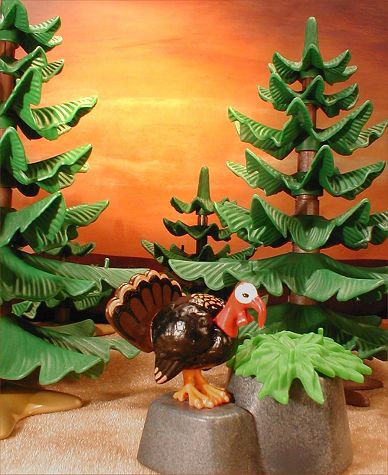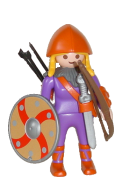I enjoy making new images for
playkingdoms which reflect specific holidays and
seasons around the world. Some events are more challenging than others because
the figures required to make scenes are not always available in playmobil® sets.
Thanksgiving Day, the holiday which commemorates a feast held in 1621 by the
Pilgrims and Wampanoag Indians (celebrated in October by Canadians and November
by Americans), is a very good example of this.

The bare bones
The symbolic image of Thanksgiving that immediately comes to mind, particularly
after extensive googling ;), is the wild turkey. As everyone no doubt knows,
playmobil® have not as yet produced this particular animal. (Fingers crossed that
it is already on the drawing board or in the planning stages).
I do like a challenge, and when I have the time, I also like playing around with
the Milliput epoxy putty that my
Just For Klicks
web-partner David (warrensde) was kind enough to send me last year. :) That said,
I decided it would be cool to have a go at creating my own playmobil®-style turkey
using the Milliput and some enamel paints.
The basis, as many have already guessed - the tail, the feet and the name, "Perkey",
are all big clues ;) - was a playmobil® peacock the same as that found in set
3894.
Actually, it was two peacocks, because the tail needed to be slightly wider than the
lowered, folded tail of one peacock.
First, I removed the wings from one bird and cut them exactly down the centre. Then,
I cut the tails off both peacocks. One tail needed to be cut to a length more suitable
for a turkey, and a small section was taken from the second peacock's tail and glued
to the larger piece to create a wider span. In reality, a turkey's tail is structured
much differently to a peacock's, but creating a more accurate shape would have
entailed moulding one from scratch - a difficult and time-consuming task - so, I
took the easiest and fastest route. ;)
The plume from the head of the peacock was cut off and a section of it cut down to
create the part of the turkey's wattle which sits on the neck. Once I had all the
playmobil® parts cut to the shape and size I needed, I set about fattening my turkey
with Milliput (a slightly unorthodox diet :p) and repositioning all the loose parts
on the turkey's body. Most stayed in place until the Milliput set, but some needed
the extra help of superglue to achieve adequate adherence. The tail was particularly
problematic because of its weight. I also moulded a sliver of Milliput for the wattle
on the beak.

Fully cooked
After the Milliput had set (the cooking process ;)), the final task was the basting--
er, I mean, painting the turkey. This was done twice because I was not satisfied with
the first attempt. :( The difficulty was finding a style that sufficiently
represented the colours and patterns of the turkey's plumage but remained simple
enough that it was not vastly different to playmobil®'s own style of design. I
decided to limit the body colours to black, dark brown, red, white and light tan
(for the highlighted pattern). I left the turkey's feet unpainted, since I felt that
playmobil® would not go to the trouble and expense of casting pink feet for just
one species of bird when they already had millions of yellow ones (trying to mimic
the thought processes of a playmobil® designer :p).
I used Humbrol and Revell enamel model paints in a matt finish. Once dried, I added
a layer of satin varnish to seal the paint. It appears slightly glossier on the
photos than it does in real life, but this is partly due to the bright lighting
used in my studio and my lack of a better camera. (A frustrated workman always blames
his tools :p).
The best part about making this conversion - aside from it actually turning out
looking a little like a turkey; I had my doubts it would! - was I learned a lot of
things about turkeys. Did you know there are 5 sub-species of wild turkey in North
America? The Eastern Wild Turkey is the most common and widely distributed, and this
is the sub-species which I attempted to recreate in my gobbler, "Perkey". Also, I
believe that the wattles of wild turkeys only change to red during the mating season,
which is earlier in the year, nowhere near the Thanksgiving period. But, hey, who
said that playmoturkeys are only for Thanksgiving?! ;)
Countess Krystal, November 2004
playkingdoms is a tribute by Playmobil® fans and collectors,
not an official site, and it is not endorsed by Playmobil® (or anyone else for that matter). No copyright infringement is intended (see full disclaimer in the
Castle).
© 1999-2025,playkingdoms




